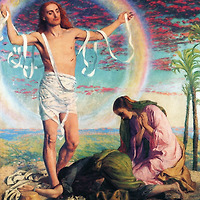
















































Genrikh Semiradsky (1843-1902)
Genrikh Semiradsky born October 24, 1843 in the village Novobelgorod (now Pechenigi) near Kharkov in the family doctor - officer of the imperial army. After graduating from the Kharkov Gymnasium entered the physical-mathematical faculty of Kharkov University, which has successfully finished in 1864.
Semiradsky with children showed an interest in painting, so after graduating, he decided to continue their education at the Imperial Academy of Fine Arts, which he graduated in 1870, with 6-year state scholarship and the opportunity to develop skills abroad.
Until 1871 Semiradsky studied in Munich from the German artist Carl von Pilot, and in 1873 moved to Rome.
In 1873 Semiradsky won the title of academician of the Academy of Arts. In the same year he married his first cousin - Mary Prushinskoy. Gerry Semiradsky mainly worked abroad. In Russia, his most important work - part in the painting galleries of the northern side wing church of Christ the Savior in Moscow. He made a huge draw on the canvas size of one of the episodes of the struggle of paganism with Christianity, namely the illumination set by the hard-Nero zazhivosozhzhennyh followers of new religions. This pattern, known as "Svetoch Nero", a brilliant artist to finalize the termination of his pensionerstva, in 1877 being exhibited in St. Petersburg, she filed a total surprise, which was accompanied by the appearance of it and at the Paris World Exhibition in 1878 for her Imperial Academy of Arts awarded Semiradsky professors, and the French government awarded him the Order of the Legion of Honor kavalerskim
Order of the Legion of Honor. Genrikh Semiradsky died August 23 (5 September) of 1902 in his estate near Radomsko Strshalkove buried in Krakow, in pantheon for Skalka.
※ 구글번역기를 통한 번역으로 오역이 있을 수 있으니 참고 하시기 바랍니다.
Genrikh Ippolitovich Semiradsky (polsk. Henryk Siemiradzki; 10 (22) October, on the other to the October 24, 1843 - 23 August 1902) - Russian painter of Polish origin, the representative of academism.
Genrikh Semiradsky born October 24, 1843 in the village Novobelgorod (now Pechenigi) near Kharkov in the family doctor - officer of the imperial army. After graduating from the Kharkov Gymnasium entered the physical-mathematical faculty of Kharkov University, which has successfully finished in 1864.
Semiradsky with children showed an interest in painting, so after graduating, he decided to continue their education at the Imperial Academy of Fine Arts, which he graduated in 1870, with 6-year state scholarship and the opportunity to develop skills abroad.
Until 1871 Semiradsky studied in Munich from the German artist Carl von Pilot, and in 1873 moved to Rome.
In 1873 Semiradsky won the title of academician of the Academy of Arts. In the same year he married his first cousin - Mary Prushinskoy. Gerry Semiradsky mainly worked abroad. In Russia, his most important work - part in the painting galleries of the northern side wing church of Christ the Savior in Moscow. He made a huge draw on the canvas size of one of the episodes of the struggle of paganism with Christianity, namely the illumination set by the hard-Nero zazhivosozhzhennyh followers of new religions. This pattern, known as "Svetoch Nero", a brilliant artist to finalize the termination of his pensionerstva, in 1877 being exhibited in St. Petersburg, she filed a total surprise, which was accompanied by the appearance of it and at the Paris World Exhibition in 1878 for her Imperial Academy of Arts awarded Semiradsky professors, and the French government awarded him the Order of the Legion of Honor kavalerskim
Order of the Legion of Honor. Genrikh Semiradsky died August 23 (5 September) of 1902 in his estate near Radomsko Strshalkove buried in Krakow, in pantheon for Skalka.
※ 구글번역기를 통한 번역으로 오역이 있을 수 있으니 참고 하시기 바랍니다.
작품명은 파일명을 그대로 옮긴 것으로 실제 작품명과 다를 수 있습니다.



